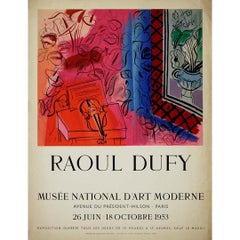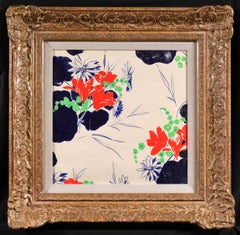Raoul Dufy Art
Raoul Dufy was a renowned French Fauvist painter, famous for his colorful, decorative designs. He was born in Le Havre, Normandy, in 1877. Dufy had a simple upbringing, leaving school at 14 to work at a Brazilian coffee-importing company. His formal artistic education began when he was eighteen at Le Havre's École des Beaux-Arts, where he took evening art classes. He continued to paint within the purlieu of Le Havre and was greatly inspired by the Impressionist landscape painters Claude Monet and Camille Pissarro. In 1900, after serving in the military for one year, Dufy won a scholarship to the École Nationale Supérieure des Beaux-Arts in Paris.
Dufy began painting watercolors of the Norman landscapes but was soon widely celebrated for his brightly colored and bold contoured paintings – in dialogue with the Fauvist style. He remained faithful to Fauvism until Paul Cézanne’s work guided him to embrace a subtler aesthetic. This new mode of sobriety saw his work return to a lighter style, which he celebrated through rapid inscription-like drawings over vivid backgrounds of color washes.
The rise of Cubism in Paris during the first two decades of the 20th century influenced him to develop a systematic approach that was later known as stenographics. Using this he experimented with foreshortened perspective, thin washes of paint and skeletal structures. In this style, he portrayed the lavish scenes of the French Riviera, leisureliness of the period, and chic revelries. Dufy was also fascinated by other amusements such as regattas, horse races and concerts and loved to depict the excitement and commotion of the crowds.
Dufy had his first exhibition in 1901 at the Salon des Artistes Français, following a string of exhibitions over the following years. In 1906 he took part in the Cercle de l’Art Moderne Exhibition in Le Havre with artists Georges Braque, Henri Matisse and Henri Charles Manguin. Dufy was given his first retrospective in 1921 at the Galerie Bernheim-Jeune and in 1932 his first painting was accepted into a national collection. He celebrated two large commissions for the 1937 Exposition Internationals des Artes et Techniques dans la Vie Moderne. The most notable of the two was the adornment for the Pavilion of Light and Electricity. He was commissioned with the task to illustrate the history of electricity from the classical era to its current position in 20th century developments. He painted La Fée électricité, a huge fresco which was donated to the Musée d’Art Moderne in 1964. In 1952 he represented France at the 26th Venice Biennale, where he won the Gran Premio. A year later he died aged 75, of polyarthritis, an illness he had been suffering from since 1937.
Find authentic Raoul Dufy prints, paintings and other art on 1stDibs.
(Biography provided by Stern Pissarro Gallery)
Mid-20th Century Abstract Geometric Raoul Dufy Art
Lithograph
1950s Modern Raoul Dufy Art
Lithograph
1960s Modern Raoul Dufy Art
Lithograph
1950s Raoul Dufy Art
Paper, Lithograph
1920s Fauvist Raoul Dufy Art
Paper, Watercolor, Gouache
Mid-20th Century Fauvist Raoul Dufy Art
Lithograph
1930s Post-Impressionist Raoul Dufy Art
Lithograph
1950s Modern Raoul Dufy Art
Lithograph
Early 20th Century Fauvist Raoul Dufy Art
Paper, Gouache
1920s Modern Raoul Dufy Art
Lithograph
1950s Modern Raoul Dufy Art
Lithograph
1910s Cubist Raoul Dufy Art
Woodcut
1920s Fauvist Raoul Dufy Art
Paper, Gouache
1920s Modern Raoul Dufy Art
Lithograph
1920s Modern Raoul Dufy Art
Lithograph
1920s Modern Raoul Dufy Art
Lithograph
1950s Modern Raoul Dufy Art
Lithograph
1940s Impressionist Raoul Dufy Art
Lithograph
20th Century Post-Impressionist Raoul Dufy Art
Watercolor, Gouache
1920s Modern Raoul Dufy Art
Lithograph
1930s Post-Impressionist Raoul Dufy Art
Lithograph
1930s Modern Raoul Dufy Art
Etching
1910s Impressionist Raoul Dufy Art
Graphite, Woodcut
1930s Modern Raoul Dufy Art
Lithograph
1960s Modern Raoul Dufy Art
Lithograph
1920s Modern Raoul Dufy Art
Lithograph
1950s Modern Raoul Dufy Art
Lithograph
1910s Impressionist Raoul Dufy Art
Woodcut
1920s Modern Raoul Dufy Art
Lithograph
1960s Abstract Geometric Raoul Dufy Art
Lithograph
1920s Surrealist Raoul Dufy Art
Paper
1950s Modern Raoul Dufy Art
Lithograph
1920s Modern Raoul Dufy Art
Lithograph
1910s Surrealist Raoul Dufy Art
Paper
1950s Impressionist Raoul Dufy Art
Etching
1930s Post-Impressionist Raoul Dufy Art
Lithograph
1910s Modern Raoul Dufy Art
Woodcut
1930s Post-Impressionist Raoul Dufy Art
Lithograph
Early 20th Century Modern Raoul Dufy Art
Lithograph
1950s Modern Raoul Dufy Art
Lithograph
1920s Modern Raoul Dufy Art
Lithograph
1910s Impressionist Raoul Dufy Art
Woodcut
1920s Fauvist Raoul Dufy Art
Paper, Watercolor, Gouache
1950s Fauvist Raoul Dufy Art
Silk, Screen
1920s Modern Raoul Dufy Art
Lithograph
1920s Fauvist Raoul Dufy Art
Gouache, Paper
1920s Raoul Dufy Art
Aquatint
1930s Post-Impressionist Raoul Dufy Art
Lithograph
1960s Abstract Geometric Raoul Dufy Art
Lithograph
Late 20th Century Raoul Dufy Art
Lithograph
1930s Art Deco Raoul Dufy Art
Paper
1930s Post-Impressionist Raoul Dufy Art
Lithograph
1940s Modern Raoul Dufy Art
Etching
1940s Modern Raoul Dufy Art
Etching
1940s Modern Raoul Dufy Art
Etching
1930s Post-Impressionist Raoul Dufy Art
Lithograph
1940s Modern Raoul Dufy Art
Etching
1940s Modern Raoul Dufy Art
Etching
1920s Impressionist Raoul Dufy Art
Lithograph
Mid-20th Century Modern Raoul Dufy Art
Pencil
Raoul Dufy art for sale on 1stDibs.
Artists Similar to Raoul Dufy
- How did Raoul Dufy paint?1 Answer1stDibs ExpertApril 5, 2022To paint, Raoul Dufy spread thin layers of quick-drying paint over a white background. Then, he would sketch objects over top using curvy, wavy lines. On 1stDibs, find a collection of Raoul Dufy art from some of the world’s top sellers.
- 1stDibs ExpertJune 6, 2024No one knows for sure how many paintings Raoul Dufy painted. However, more than 160 of his works are known. Some of his most famous pieces include Boats at Martigues, Bathers, The Mexican Musicians, The Kessler Family on Horseback and Regatta at Cowes. On 1stDibs, explore a range of Raoul Dufy art.
- Who was Raoul Dufy inspired by?1 Answer1stDibs ExpertApril 5, 2022Painter, drawer, designer and printmaker Raoul Dufy was greatly inspired by impressionists like Camille Pissarro and Claude Monet. In later years, he took inspiration from Henri Matisse’s Luxe, Calme et Volupté. And even later in his work, he evolved again after connecting with the work of Paul Cézanne and Cubism. After this era, he developed his own style and distinctive artistic approach. On 1stDibs, find a variety of original artwork from top artists.
- 1stDibs ExpertNovember 26, 2024To identify a lithograph print, begin by conducting a reverse image search. By taking a photo with your mobile device and performing a reverse image search, you may quickly find a match and learn the artist, title and other characteristics of your lithograph. Should this method of identification yield no results, look for an artist's signature or publisher's information on the front or back of the piece. Researching the maker or publisher via trusted online resources can help you learn more about your print. For help with the process, consult a certified appraiser or experienced art dealer. On 1stDibs, shop a wide range of lithograph prints.

